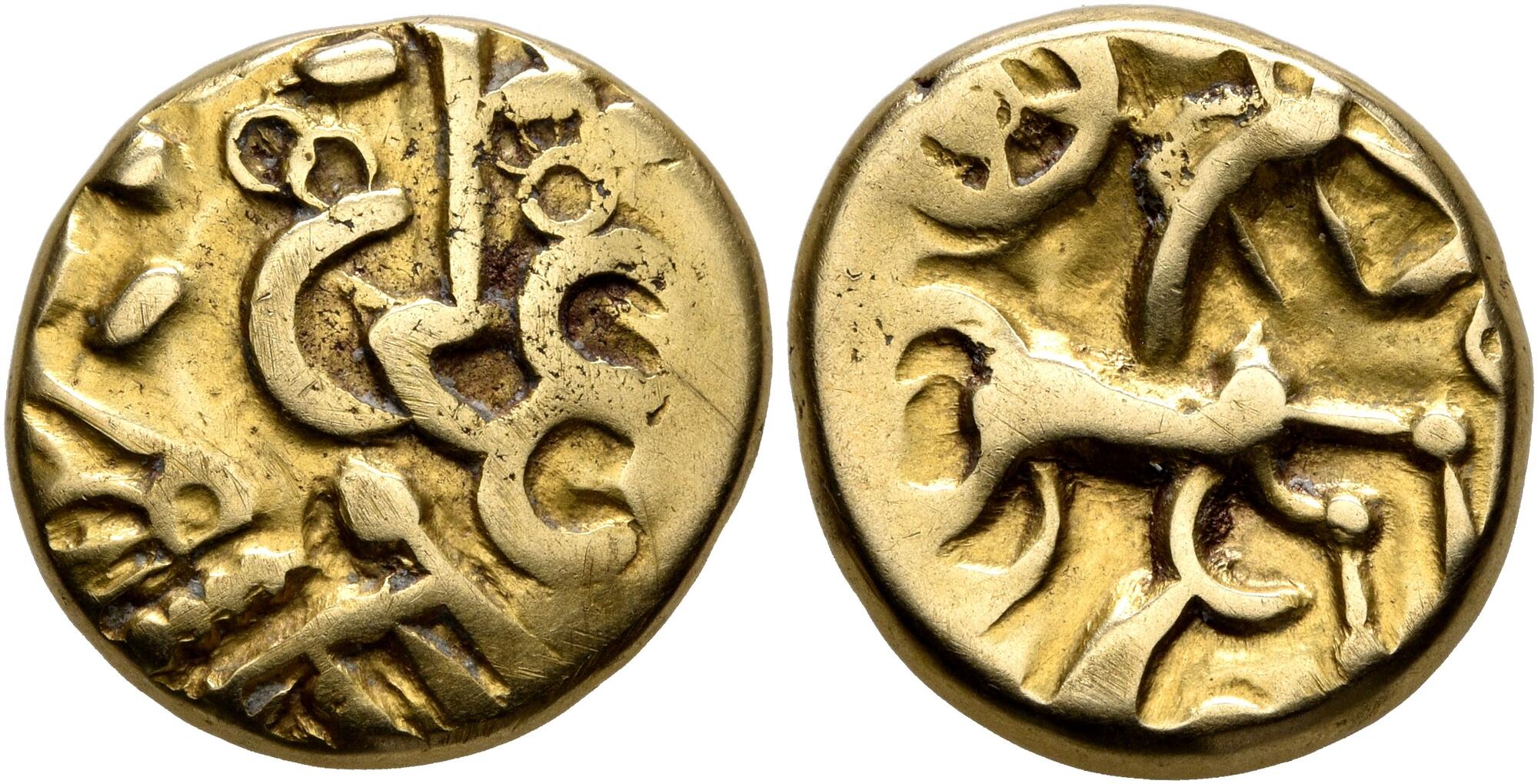Thuin (Nervii), gold, staters with the epsilon (70-30 BCE)
From SILVER
70 BCE - 30 BCE Gold 101,852 kg
Description
| ObverseInscription or printing placed on the obverse.: | Devolved and disjointed laureate male head to right. |
| ReverseInscription or printing placed on the reverse.: | Celticized horse galloping to right, above, wheel |
Mint and issuing power
| MintIdentifies the place of manufacture or issue of a numismatic object.: | Thuin | Ancient regionAncient region.: | Gallia | Modern countryModern country: Belgium | AuthorityIdentifies the issuing power. The authority can be "pretended" when the name or the portrait of X is on the coin but he/she was not the issuing power. It can also be "uncertain" when there is no mention of X on the coin but he/she was the issuing power according to the historical sources: | Celtic numismatics, Nervii |
Chronology
| FromIdentifies the initial date in a range assigned in a numismatic context. | 70 BCE | toIdentifies the final date in a range assigned in a numismatic context.. | 30 BCE | PeriodTime period of the numismatic object.: |
Physical description
| MetalThe physical material (usually metal) from which an object is made.: | Gold |
Median weightMedian of the weights of numismatic objects (in grams). in grams | 5.95 | DenominationTerm indicating the value of a numismatic object. Examples: tetradrachm, chalkous, denarius.: | stater |
StandardStandard.: |
Image

Nervii epsilon staters.jpg [1]
References
| Die study referencePublication of the study: | Scheers - Creemers 20121Scheers - Creemers 2012, Scheers et al. 20122Scheers et al. 2012 | ||
| Coin series referenceReference to coin series study: | |||
Obverse dies distribution
| FrequencyFrequency of specimen in distribution. ᵖ | Number of obversesNumber of obverse dies. ᵖ (o) | % (o) | Number of coinsNumber of coins. (n) | % (n) | Die nameName(s) of the die(s). |
| 1 | 30 | 42.86 | 30 | 12.77 | 1, 12, 14, 15, 17, 19, 20, 25, 28, 30, 31, 32, 33, 34, 35, 36, 37, 39, 40, 42, 43, 44, 47, 49, 53, 54, 55, 64, 67, 70 |
| 2 | 11 | 15.71 | 22 | 9.36 | 4, 5, 7, 21, 23, 24, 27, 29, 38, 62, 63 |
| 3 | 12 | 17.14 | 36 | 15.32 | 2, 6, 10, 13, 16, 22, 41, 45, 46, 48, 61, 65 |
| 4 | 5 | 7.14 | 20 | 8.51 | 8, 9, 18, 26, 60 |
| 5 | 1 | 1.43 | 5 | 2.13 | 11 |
| 7 | 5 | 7.14 | 35 | 14.89 | 15, 51, 52, 58, 59 |
| 8 | 1 | 1.43 | 8 | 3.4 | 57 |
| 13 | 1 | 1.43 | 13 | 5.53 | 50 |
| 14 | 2 | 2.86 | 28 | 11.91 | 66, 68 |
| 17 | 1 | 1.43 | 17 | 7.23 | 69 |
| 21 | 1 | 1.43 | 21 | 8.94 | 56 |
| Total | 70 of 70 | 100 | 235 of 235 | 99.99 |
Reverse dies distribution
no distribution is available
Quantification
| Number of obversesNumber of obverse dies. ᵖ (o) | 70 | Number of singletons (o1)The number of singleton coins. ᵖ | 30 |
| Number of reverse diesNumber of reverse dies. (r) | 122 | Number of coinsNumber of coins. (n) | 235 |
| Coins per obverse dieNumber of coins per obverse die. (n/o) | 3.36 | Coins per reverse dieNumber of coins per reverse die. (n/r) | 1.93 |
| Reverse per obverse ratioRatio of obverse dies divided by reverse dies. (r/o) | 1.74 | Percentage of singletons (o1)number of coins (n) divided by the number of singletons (o1) ᵖ | 42.86 % |
| Original number of dies (O) (Carter 1983 formula)The estimation of the number of coins according to Carter 1983 ᵖ | 85.59 | Coins struck if 20,000 as average productivity per dieCoins made if the average productivity for obverses (according to Carter) is 20,000. ᵖ | 1,711,800 |
| Original number of dies (O) (Esty 2011 formula)The estimation of the number of coins according to the singleton formula in Esty 2011 ᵖ (O) | 99.7 | Survival rate if 20,000 as average productivity per dieSurvival rate if average productivity is 20,000. ᵖ | 0.00014 |
| Coverage (o = % of O) (Esty 1984 formula)Esty 1984 - coverage (% of O) ᵖ (o = % of O) | 87.23% | Die productivity if survival rate 1/2,000Average productivity if survival rate is 1/2,000. ᵖ | 5,491.3 |
| Weight of silver (in kg) if 20,000 coins per die (O = Carter formula)Carter 1983 * Median weight * 20000 (*10 if gold or electrum) ᵖ | 101,852 kg <br /> 101,852 kg | Die productivity if survival rate 1/5,000Average productivity if survival rate is 1/5,000. ᵖ | 13,728.24 |
Remarks
Most likely one single workstation Likely military